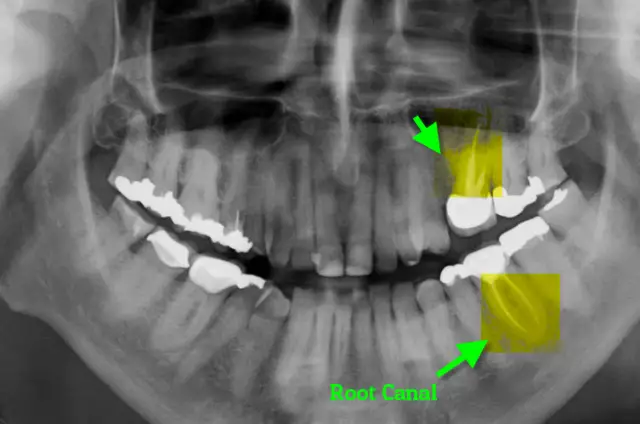- Author Rachel Wainwright [email protected].
- Public 2023-12-15 07:39.
- Last modified 2025-11-02 20:14.
Sulfasalazine
Instructions for use:
- 1. Release form
- 2. Analogs
- 3. Pharmacological action
- 4. Indications for use
- 5. Contraindications
- 6. Method of application
- 7. Side effects
- 8. Drug interactions
- 9. Storage conditions
Prices in online pharmacies:
from 198 rub.
Buy

Sulfasalazine is an anti-inflammatory drug used to treat exacerbations of ulcerative colitis, rheumatoid arthritis, and Crohn's disease.
Release form
The drug Sulfasalazine is produced in the form of yellow-brown film-coated tablets containing 500 mg of the active substance of the same name (azo compounds of sulfapyridine with salicylic acid). 10 pieces per pack.
Sulfasalazine analogs
The closest analogues of Sulfasalazine in terms of mode of action include drugs in the dosage form of tablets: Asakol, Mesakol, Samezil, Mezavant, Salofalk, Mesalazin, Pentasa and Kansalazin.
In addition, analogues of Sulfasalazine are produced in other dosage forms. These include:
- Rectal suspension - Salofalk, Samezil;
- Rectal suppositories - Pentasa;
- Oral suspension - Salazopyridazine;
- Dosed rectal foam - Salofalk.
Pharmacological action of Sulfasalazine
The active component of Sulfasalazine has both anti-inflammatory and antimicrobial effects against pathogens of intestinal diseases.
The use of Sulfasalazine in the treatment of nonspecific colitis is effective due to the ability of the active component of the drug to selectively accumulate in the tissues of the intestinal walls and release acids that have anti-inflammatory activity, as well as to have an antimicrobial effect against Streptococcus spp., Including Neisseria gonorrhoeae, Streptococcus pneumoniae and Escherichia.
Indications for the use of Sulfasalazine
According to the instructions, Sulfasalazine is prescribed for the treatment of:
- Exacerbations of ulcerative colitis, as well as for maintenance therapy in remission;
- Rheumatoid arthritis and juvenile rheumatoid arthritis in cases where standard therapy with non-steroidal anti-inflammatory drugs has been ineffective;
- Crohn's disease, which occurs in mild and moderate forms in the acute phase.
Contraindications
The use of Sulfasalazine is contraindicated in the following cases:
- With aplastic anemia;
- With hepatic and renal failure;
- With congenital deficiency of glucose-6-phosphate dehydrogenase;
- During lactation;
- With porphyrias;
- Under the age of 5;
- With obstruction of the intestine or urinary tract;
- With granulocytopenia;
- In case of hypersensitivity to the active or auxiliary components of Sulfasalazine.
In addition, according to reviews, Sulfasalazine should be taken with caution when:
- Atopic dermatitis;
- Bronchial asthma;
- A history of allergic reactions to sulfonamide derivatives;
- Pregnancy;
- Systemic forms of juvenile rheumatoid arthritis (due to an increased risk of developing serum sickness).
Method of using Sulfasalazine
Sulfasalazine according to the instructions is recommended to be taken after meals.
Adults and children over 16 years of age for the treatment of ulcerative colitis and Crohn's disease:
- On the first day of treatment, take one tablet of Sulfasalazine 4 times a day;
- On the second day - double the dosage;
- On the third and subsequent days - 3-4 tablets 4 times a day.
Supportive therapy with sulfasalazine is prescribed after a decrease in acute clinical symptoms in a dosage of 2 g, divided into four doses, lasting at least several months.
The maximum daily dose of Sulfasalazine for adults is 16 tablets per day, for children under 16 years of age - 2 g per day.
In the treatment of juvenile rheumatoid arthritis and rheumatoid arthritis, adults and children over 16 years of age are prescribed:
- During the first week - 1 tablet once a day;
- During the second week - 1 tablet twice a day;
- During the third week - 1 tablet three times a day.
According to this scheme, gradually, over 5-6 weeks of therapy, the dose taken is adjusted to 1.5-3 g per day. As a rule, a persistent clinical effect appears after several months. The average duration of treatment is from six months.
The dosage of Sulfasalazine for children is calculated by the doctor and depends on age and body weight, however, the daily dose should not exceed 40-50 mg / kg of body weight or 2 g of the drug.
Side effects of sulfasalazine
According to reviews, sulfasalazine can cause disturbances from various body systems:
- Genitourinary system - hematuria, proteinuria, nephrotic syndrome, crystalluria;
- Nervous system - peripheral neuropathy, headache, aseptic meningitis, hallucinations, dizziness, sleep disturbances, convulsions, depression, ataxia;
- Respiratory system - infiltrates in the lung tissue, shortness of breath, interstitial fibrosing alveolitis, pneumonitis, cough;
- Digestive system - pancreatitis, vomiting, drug hepatitis, nausea, abdominal pain, diarrhea, stomatitis, loss of appetite.
Violations of the hematopoietic organs when taking Sulfasalazine according to reviews are most often manifested in the form of leukopenia, macrocytosis, megaloblastic anemia, neutropenia, aplastic, hemolytic and hemolytic anemia, agranulocytosis, methemoglobinemia, hypoprothrombinemia, thrombocytopenia.
The most common allergic reactions when using Sulfasalazine are:
- Generalized skin rash;
- Erythema;
- Hives;
- Exfoliative dermatitis;
- Itchy skin;
- Anaphylactic shock;
- Malignant exudative erythema;
- Photosensitization;
- Toxic epidermal necrolysis (Lyell's syndrome);
- Lymphadenopathy;
- Fever;
- Periorbital edema;
- Serum sickness;
- Periarteritis nodosa;
- Eosinophilia.
In addition, according to reviews, taking Sulfasalazine can lead to the development of mumps, tinnitus, hyperthermia and hyperbilirubinemia.
Taking large doses of Sulfasalazine, as a rule, leads to an overdose, which is expressed in the form of digestive disorders (vomiting, nausea, abdominal pain) and dizziness. The use of sulfasalazine in very high doses most often causes crystalluria, anuria, convulsions and hematuria.
Drug interactions
The simultaneous use of sulfasalazine with anticoagulants, antiepileptic and oral hypoglycemic drugs enhances the effect of the latter.
The risk of developing myelosuppression increases with simultaneous use with drugs that inhibit bone marrow hematopoiesis.
An increase in the severity of side effects is possible with the combined use of Sulfasalazine with cytostatics, immunosuppressants and nephrotoxic drugs.
The effectiveness of sulfasalazine in the treatment of ulcerative colitis is reduced by antimicrobial drugs, which is associated with a depressing effect on the intestinal microflora.
Storage conditions
Sulfasalazine is dispensed by prescription according to the instructions. The shelf life under the temperature conditions (up to 25 ° C) should not exceed five years.
Sulfasalazine: prices in online pharmacies
|
Drug name Price Pharmacy |
|
Sulfasalazine 500 mg film-coated tablets 50 pcs. 198 RUB Buy |
|
Sulfasalazine 500 mg film-coated tablets 50 pcs. 349 r Buy |
Information about the drug is generalized, provided for informational purposes only and does not replace the official instructions. Self-medication is hazardous to health!






